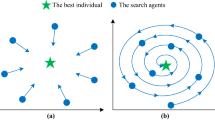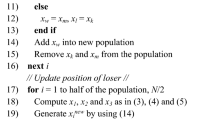Abstract
It is feasible to increase the comfort level of the paralyzed people with the aid of a biomedical application known as functional electrical stimulation system. With the aid of this system, the paralyzed people can perform movements that are normally difficult for them to carry out making functional electrical stimulation a significant solution for disabled individuals. However, to take the advantage of a functional electrical stimulation system, an appropriate control method must be employed. In this work, therefore, a new control approach is presented by employing a proportional-integral-derivative (PID) controller, a modified integral of time multiplied squared error performance index and a novel enhanced metaheuristic tuning algorithm named multi-criteria-based weighted mean of vectors algorithm (MC-INFO). The tuning algorithm is basically an improved version of original weighted mean of vectors algorithm (INFO) using an elite opposition-based and random learning and pattern search mechanisms. In here, elite opposition-based learning and random learning mechanisms are used for further explorative capability whereas pattern search helps to reach better exploitation. Unimodal, multimodal, and low-dimensional benchmark functions demonstrate the good performance of the proposed MC-INFO algorithm against several other metaheuristic algorithms. The proposed algorithm is used to tune the PID controlled functional electrical stimulation system with the aid of the modified objective function. The overall better capacity of the proposed control method for functional electrical stimulation system is demonstrated comparatively with statistical test, transient and frequency responses using original weighted mean of vectors algorithm, reptile search algorithm, moth-flame optimization algorithm and traditional Ziegler–Nichols-based PID controllers. Further confirmation is provided via comparative assessment against previously reported methods, as well.






Similar content being viewed by others
References
Abualigah, L., Elaziz, M. A., Sumari, P., et al. (2021). Reptile Search Algorithm (RSA): A nature-inspired meta-heuristic optimizer. Expert Systems with Applications. https://doi.org/10.1016/j.eswa.2021.116158
Ahmadianfar, I., Heidari, A. A., Noshadian, S., et al. (2022). INFO: An efficient optimization algorithm based on weighted mean of vectors. Expert Systems with Applications, 195, 116516. https://doi.org/10.1016/j.eswa.2022.116516
Barbosa, W.S., Temporao, G.P., Meggiolaro, M.A. (2021). Control techniques for neuromuscular electrical stimulation: A brief survey. In 2021 IEEE International Conference on Bioinformatics and Biomedicine (BIBM). IEEE, pp 2998–3005
Boudville, R., Hussain, Z., Yahaya, S.Z., et al. (2018). Development and optimization of PID control for FES knee exercise in hemiplegic rehabilitation. In 2018 12th International Conference on Sensing Technology (ICST). IEEE, pp 143–148
Ekinci, S., Izci, D., Al Nasar, M. R., et al. (2022). Logarithmic spiral search based arithmetic optimization algorithm with selective mechanism and its application to functional electrical stimulation system control. Soft Computing. https://doi.org/10.1007/s00500-022-07068-x
Eslami, M., Neshat, M., & Khalid, S. A. (2022). A novel hybrid sine cosine algorithm and pattern search for optimal coordination of power system damping controllers. Sustainability, 14, 541. https://doi.org/10.3390/su14010541
Hill, A. V. (1938). The heat of shortening and the dynamic constants of muscle. Proc R Soc London Ser B - Biol Sci, 126, 136–195. https://doi.org/10.1098/rspb.1938.0050
Izci, D., Ekinci, S., Eker, E., Abualigah, L. (2022a) Opposition-based arithmetic optimization algorithm with varying acceleration coefficient for function optimization and control of FES system. In Uddin MS, Jamwal PK, Bansal JC (eds) Proceedings of International Joint Conference on Advances in Computational Intelligence, 1st edn. Springer Singapore, pp 283–293
Izci, D. (2021). Design and application of an optimally tuned PID controller for DC motor speed regulation via a novel hybrid Lévy flight distribution and Nelder-Mead algorithm. Transactions of the Institute of Measurement and Control, 43, 3195–3211. https://doi.org/10.1177/01423312211019633
Izci, D., & Ekinci, S. (2021). Comparative performance analysis of slime mould algorithm for efficient design of proportional–integral–derivative controller. Electrica, 21, 151–159. https://doi.org/10.5152/electrica.2021.20077
Izci, D., Ekinci, S., Eker, E., & Kayri, M. (2022b). Augmented hunger games search algorithm using logarithmic spiral opposition-based learning for function optimization and controller design. J King Saud Univ - Eng Sci. https://doi.org/10.1016/j.jksues.2022.03.001
Khanduja, N., & Bhushan, B. (2021). Chaotic state of matter search with elite opposition based learning: A new hybrid metaheuristic algorithm. Optim Control Appl Methods. https://doi.org/10.1002/oca.2810
Kirsch, N., Alibeji, N., & Sharma, N. (2017). Nonlinear model predictive control of functional electrical stimulation. Control Engineering Practice, 58, 319–331. https://doi.org/10.1016/j.conengprac.2016.03.005
Lynch, C. L., & Popovic, M. R. (2008). Functional electrical stimulation. Control Syst, 28, 40–50. https://doi.org/10.1109/MCS.2007.914689
Mirjalili, S. (2015). Moth-flame optimization algorithm: A novel nature-inspired heuristic paradigm. Knowledge-Based Syst, 89, 228–249. https://doi.org/10.1016/j.knosys.2015.07.006
Nekoukar, V. (2021). Control of functional electrical stimulation systems using simultaneous pulse width, amplitude, and frequency modulations. Neuromodulation Technol Neural Interface, 24, 1467–1474. https://doi.org/10.1111/ner.13126
Nekoukar, V., & Erfanian, A. (2012). A decentralized modular control framework for robust control of FES-activated walker-assisted paraplegic walking using terminal sliding mode and fuzzy logic control. IEEE Transactions on Biomedical Engineering, 59, 2818–2827. https://doi.org/10.1109/TBME.2012.2208963
Poboroniuc, M.-S., Irimia, D-C, Baciu, A. et al. (2018). A fuzzy controller to support FES-based sitting-down in paraplegia. In 2018 International Conference and Exposition on Electrical And Power Engineering (EPE). IEEE, pp 0523–0528
Previdi, F., & Carpanzano, E. (2003). Design of a gain scheduling controller for knee-joint angle control by using functional electrical stimulation. IEEE Transactions on Control Systems Technology, 11, 310–324. https://doi.org/10.1109/TCST.2003.810380
Sharif Razavian, R., Ghannadi, B., Mehrabi, N., et al. (2018). Feedback control of functional electrical stimulation for 2-D Arm reaching movements. IEEE Transactions on Neural Systems and Rehabilitation Engineering, 26, 2033–2043. https://doi.org/10.1109/TNSRE.2018.2853573
Tizhoosh H. R. (2005). Opposition-based learning: A new scheme for machine intelligence. in: international conference on computational intelligence for modelling, control and automation and international conference on intelligent agents, web technologies and internet commerce (CIMCA-IAWTIC’06). IEEE, pp 695–701
Torczon, V. (1997). On the convergence of pattern search algorithms. SIAM Journal on Optimization, 7, 1–25. https://doi.org/10.1137/S1052623493250780
Yan, B., Zhao, Z., Zhou, Y., et al. (2017). A particle swarm optimization algorithm with random learning mechanism and Levy flight for optimization of atomic clusters. Computer Physics Communications, 219, 79–86. https://doi.org/10.1016/j.cpc.2017.05.009
Author information
Authors and Affiliations
Corresponding author
Ethics declarations
Conflict of interest
No conflict of interest.
Additional information
Publisher's Note
Springer Nature remains neutral with regard to jurisdictional claims in published maps and institutional affiliations.
Rights and permissions
Springer Nature or its licensor holds exclusive rights to this article under a publishing agreement with the author(s) or other rightsholder(s); author self-archiving of the accepted manuscript version of this article is solely governed by the terms of such publishing agreement and applicable law.
About this article
Cite this article
Izci, D., Ekinci, S., Eker, E. et al. Biomedical Application of a Random Learning and Elite Opposition-Based Weighted Mean of Vectors Algorithm with Pattern Search Mechanism. J Control Autom Electr Syst 34, 333–343 (2023). https://doi.org/10.1007/s40313-022-00959-2
Received:
Revised:
Accepted:
Published:
Issue Date:
DOI: https://doi.org/10.1007/s40313-022-00959-2




